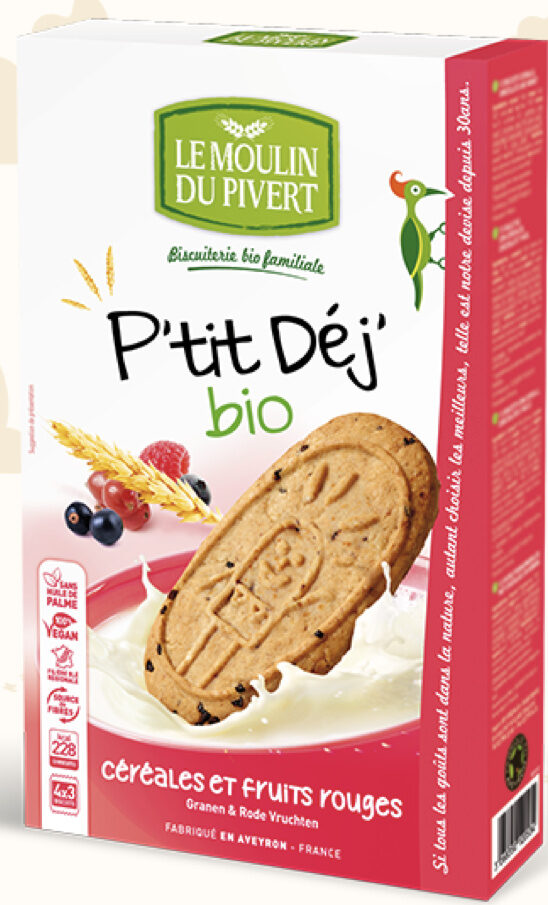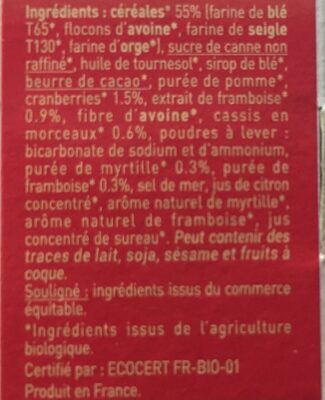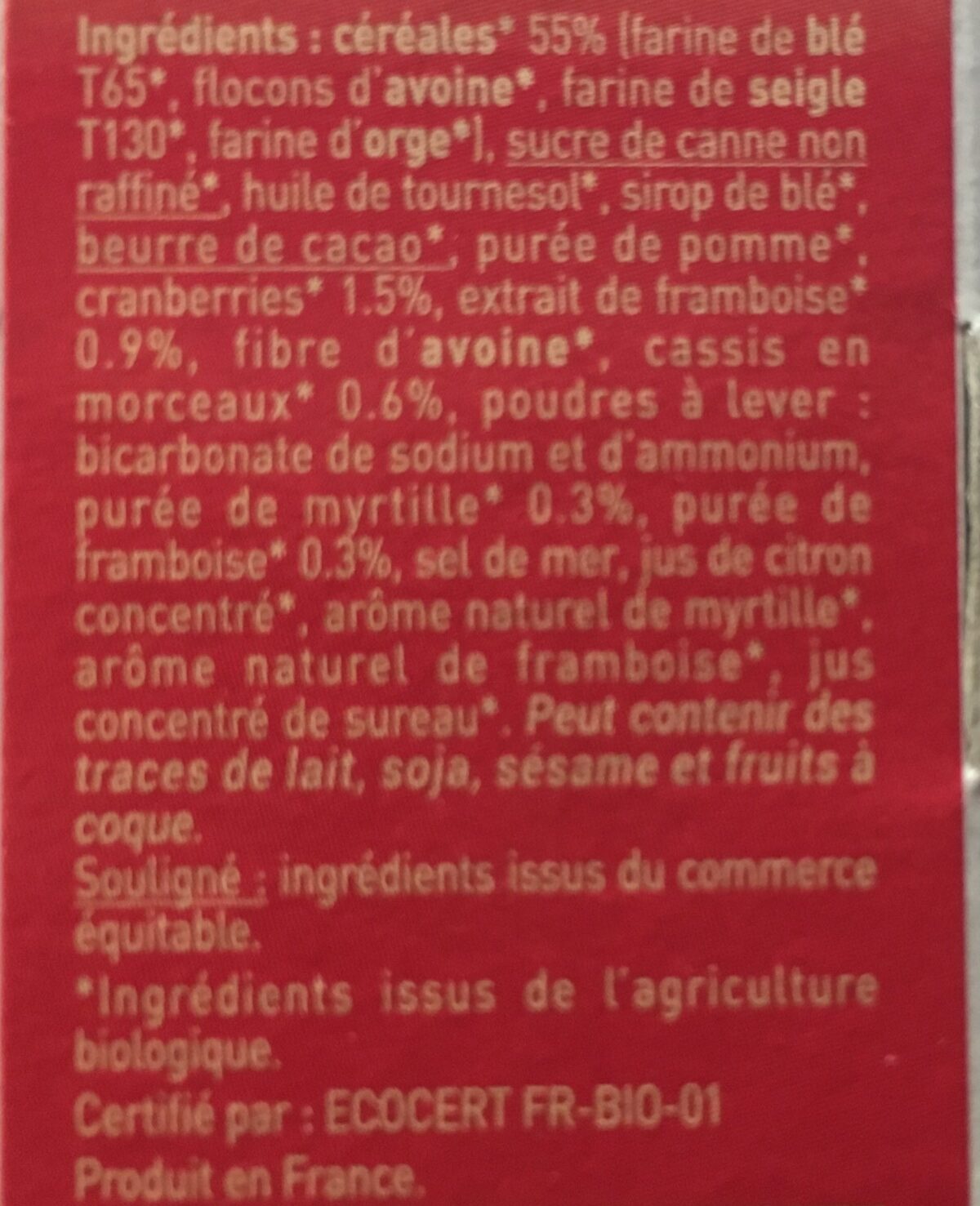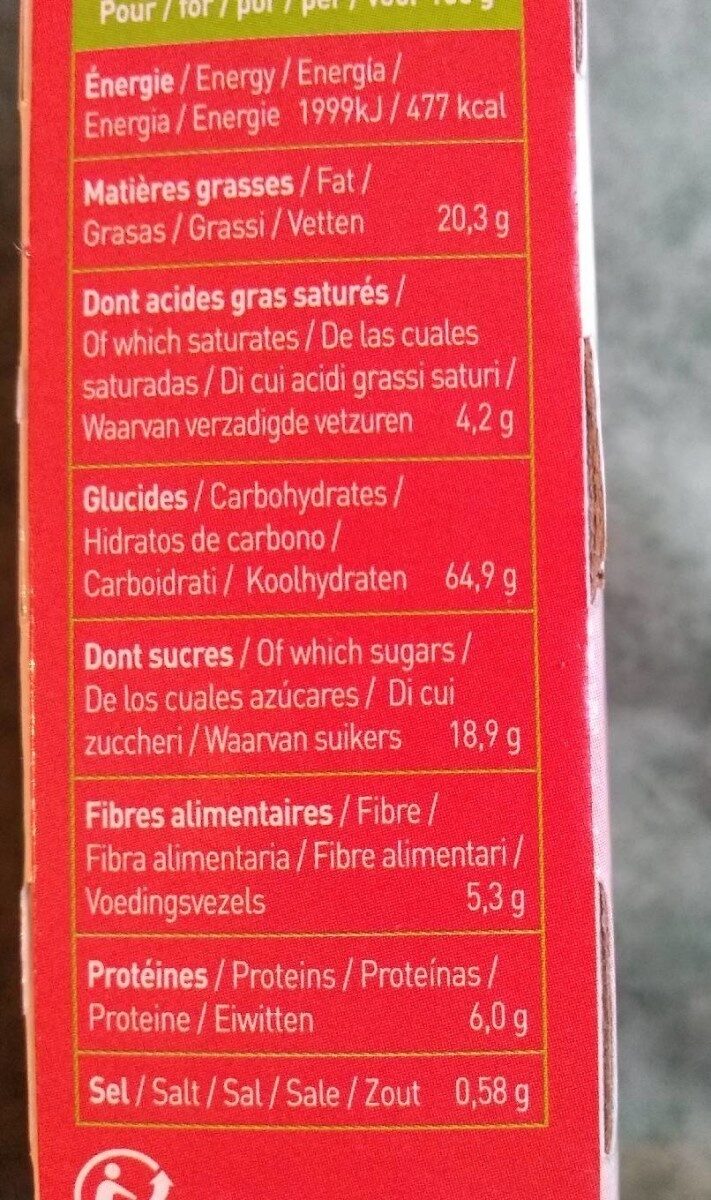Help us make food transparency the norm!
As a non-profit organization, we depend on your donations to continue informing consumers around the world about what they eat.
The food revolution starts with you!
Biscuits P'tit Déj' bio - Céréales et fruits rouges - Le Moulin du Pivert - 190 g
Biscuits P'tit Déj' bio - Céréales et fruits rouges - Le Moulin du Pivert - 190 g
This product page is not complete. You can help to complete it by editing it and adding more data from the photos we have, or by taking more photos using the app for Android or iPhone/iPad. Thank you!
×
Barcode: 3268350120718 (EAN / EAN-13)
Common name: Biscuits p'tit déj céréales et fruits rouges
Quantity: 190 g
Packaging: Plastic, Box, Cardboard
Brands: Le Moulin du Pivert
Categories: Snacks, Sweet snacks, Biscuits and cakes, Biscuits
Labels, certifications, awards:
Fair trade, Organic, Vegetarian, EU Organic, Non-EU Agriculture, Vegan, EU Agriculture, EU/non-EU Agriculture, FR-BIO-01, Green Dot, No palm oil, AB Agriculture Biologique


Origin of ingredients: France
Manufacturing or processing places: Lunac, Aveyron, Midi-Pyrénées, France
Link to the product page on the official site of the producer: http://www.lemoulindupivert.com/produits...
Stores: Les Nouveaux Robinson
Countries where sold: France
Matching with your preferences
Health
Ingredients
-
24 ingredients
French: Céréales 55% (farine de blé T65, flocons d'avoine, farine de seigle T130, farine d'orge), sucre de canne non raffiné, huile de tournesol, sirop de blé, beurre de cacao, purée de pomme, cranberries 1.5%, extrait de framboise 0.9%, fibre d'avoine, cassis en morceaux 0.6%, poudre à lever : bicarbonate de sodium et d'ammonium, purée de myrtille 0.3%, purée de framboise 0.3%, sel de mer, jus de citron concentré, arôme naturel de myrtille, arôme naturel de framboise, jus concentré de sureau.Allergens: GlutenTraces: Milk, Nuts, Sesame seeds, Soybeans
Food processing
-
Ultra processed foods
Elements that indicate the product is in the 4 - Ultra processed food and drink products group:
- Ingredient: Flavouring
Food products are classified into 4 groups according to their degree of processing:
- Unprocessed or minimally processed foods
- Processed culinary ingredients
- Processed foods
- Ultra processed foods
The determination of the group is based on the category of the product and on the ingredients it contains.
Additives
-
E500 - Sodium carbonates
Sodium carbonates (E500) are compounds commonly used in food preparation as leavening agents, helping baked goods rise by releasing carbon dioxide when they interact with acids.
Often found in baking soda, they regulate the pH of food, preventing it from becoming too acidic or too alkaline. In the culinary world, sodium carbonates can also enhance the texture and structure of foods, such as noodles, by modifying the gluten network.
Generally recognized as safe, sodium carbonates are non-toxic when consumed in typical amounts found in food.
-
E500ii - Sodium hydrogen carbonate
Sodium hydrogen carbonate, also known as E500ii, is a food additive commonly used as a leavening agent.
When added to recipes, it releases carbon dioxide gas upon exposure to heat or acids, causing dough to rise and resulting in a light, fluffy texture in baked goods.
It is generally recognized as safe (GRAS) by regulatory authorities when used in appropriate quantities and poses no significant health risks when consumed in typical food applications.
-
E503 - Ammonium carbonates
Ammonium carbonate: Ammonium carbonate is a salt with the chemical formula -NH4-2CO3. Since it readily degrades to gaseous ammonia and carbon dioxide upon heating, it is used as a leavening agent and also as smelling salt. It is also known as baker's ammonia and was a predecessor to the more modern leavening agents baking soda and baking powder. It is a component of what was formerly known as sal volatile and salt of hartshorn.Source: Wikipedia
-
E503i - Ammonium carbonate
Ammonium carbonate: Ammonium carbonate is a salt with the chemical formula -NH4-2CO3. Since it readily degrades to gaseous ammonia and carbon dioxide upon heating, it is used as a leavening agent and also as smelling salt. It is also known as baker's ammonia and was a predecessor to the more modern leavening agents baking soda and baking powder. It is a component of what was formerly known as sal volatile and salt of hartshorn.Source: Wikipedia
Ingredients analysis
-
Palm oil free
No ingredients containing palm oil detected
-
Vegan
No non-vegan ingredients
Unrecognized ingredients: Wheat syrup
-
Vegetarian
No non-vegetarian ingredients detected
Unrecognized ingredients: Wheat syrup
-
Details of the analysis of the ingredients
fr: Céréales 55% (farine de blé T65, flocons d'avoine, farine de seigle T130, farine d'orge), sucre de canne non raffiné, huile de tournesol, sirop de blé, beurre de cacao, purée de pomme, cranberries 1.5%, framboise 0.9%, fibre d'avoine, cassis 0.6%, poudre à lever (bicarbonate de sodium), carbonate d'ammonium, myrtille 0.3%, purée de framboise 0.3%, sel de mer, jus de citron concentré, arôme naturel de myrtille, arôme naturel de framboise, jus concentré de sureau- Céréales -> en:cereal - vegan: yes - vegetarian: yes - percent_min: 55 - percent: 55 - percent_max: 55
- farine de blé T65 -> fr:farine-de-ble-type-65 - vegan: yes - vegetarian: yes - ciqual_proxy_food_code: 9410 - percent_min: 13.75 - percent_max: 55
- flocons d'avoine -> en:oat-flakes - vegan: yes - vegetarian: yes - ciqual_food_code: 9311 - percent_min: 0 - percent_max: 27.5
- farine de seigle T130 -> en:rye-flour-type-130 - vegan: yes - vegetarian: yes - ciqual_food_code: 9533 - percent_min: 0 - percent_max: 18.3333333333333
- farine d'orge -> en:barley-flour - vegan: yes - vegetarian: yes - ciqual_food_code: 9550 - percent_min: 0 - percent_max: 13.75
- sucre de canne non raffiné -> en:unrefined-cane-sugar - vegan: yes - vegetarian: yes - ciqual_proxy_food_code: 31016 - percent_min: 2.5 - percent_max: 34.2
- huile de tournesol -> en:sunflower-oil - vegan: yes - vegetarian: yes - from_palm_oil: no - ciqual_food_code: 17440 - percent_min: 1.5 - percent_max: 30.2333333333333
- sirop de blé -> en:wheat-syrup - percent_min: 1.5 - percent_max: 21.25
- beurre de cacao -> en:cocoa-butter - vegan: yes - vegetarian: yes - ciqual_food_code: 16030 - percent_min: 1.5 - percent_max: 13.6666666666667
- purée de pomme -> en:apple-puree - vegan: maybe - vegetarian: maybe - ciqual_food_code: 13050 - percent_min: 1.5 - percent_max: 9.875
- cranberries -> en:cranberry - vegan: yes - vegetarian: yes - ciqual_food_code: 13113 - percent_min: 1.5 - percent: 1.5 - percent_max: 1.5
- framboise -> en:raspberry - vegan: yes - vegetarian: yes - ciqual_food_code: 13015 - percent_min: 0.9 - percent: 0.9 - percent_max: 0.9
- fibre d'avoine -> en:oat-fibre - vegan: yes - vegetarian: yes - ciqual_food_code: 9310 - percent_min: 0.6 - percent_max: 0.9
- cassis -> en:blackcurrant - vegan: yes - vegetarian: yes - ciqual_food_code: 13007 - percent_min: 0.6 - percent: 0.6 - percent_max: 0.6
- poudre à lever -> en:raising-agent - percent_min: 0.3 - percent_max: 0.6
- bicarbonate de sodium -> en:e500ii - vegan: yes - vegetarian: yes - percent_min: 0.3 - percent_max: 0.6
- carbonate d'ammonium -> en:e503i - vegan: yes - vegetarian: yes - percent_min: 0.3 - percent_max: 0.6
- myrtille -> en:blueberry - vegan: yes - vegetarian: yes - ciqual_food_code: 13028 - percent_min: 0.3 - percent: 0.3 - percent_max: 0.3
- purée de framboise -> en:raspberry-puree - vegan: maybe - vegetarian: maybe - ciqual_food_code: 13015 - percent_min: 0.3 - percent: 0.3 - percent_max: 0.3
- sel de mer -> en:sea-salt - vegan: yes - vegetarian: yes - ciqual_food_code: 11082 - percent_min: 0 - percent_max: 0.3
- jus de citron concentré -> en:concentrated-lemon-juice - vegan: yes - vegetarian: yes - ciqual_food_code: 2028 - percent_min: 0 - percent_max: 0.3
- arôme naturel de myrtille -> en:natural-blueberry-flavouring - vegan: maybe - vegetarian: maybe - percent_min: 0 - percent_max: 0.3
- arôme naturel de framboise -> en:natural-raspberry-flavouring - vegan: maybe - vegetarian: maybe - percent_min: 0 - percent_max: 0.3
- jus concentré de sureau -> en:elderberry-juice-concentrate - vegan: yes - vegetarian: yes - ciqual_food_code: 13126 - percent_min: 0 - percent_max: 0.3
- Céréales -> en:cereal - vegan: yes - vegetarian: yes - percent_min: 55 - percent: 55 - percent_max: 55
Nutrition
-
Average nutritional quality
⚠ ️Warning: the amount of fruits, vegetables and nuts is not specified on the label, it was estimated from the list of ingredients: 5This product is not considered a beverage for the calculation of the Nutri-Score.
Positive points: 5
- Proteins: 3 / 5 (value: 6, rounded value: 6)
- Fiber: 5 / 5 (value: 4.9, rounded value: 4.9)
- Fruits, vegetables, nuts, and colza/walnut/olive oils: 0 / 5 (value: 5.359375, rounded value: 5.4)
Negative points: 15
- Energy: 5 / 10 (value: 1996, rounded value: 1996)
- Sugars: 4 / 10 (value: 18.9, rounded value: 18.9)
- Saturated fat: 4 / 10 (value: 4.2, rounded value: 4.2)
- Sodium: 2 / 10 (value: 232, rounded value: 232)
The points for proteins are not counted because the negative points are greater or equal to 11.
Nutritional score: (15 - 5)
Nutri-Score:
-
Nutrient levels
-
Fat in high quantity (20.3%)
What you need to know- A high consumption of fat, especially saturated fats, can raise cholesterol, which increases the risk of heart diseases.
Recommendation: Limit the consumption of fat and saturated fat- Choose products with lower fat and saturated fat content.
-
Saturated fat in moderate quantity (4.2%)
What you need to know- A high consumption of fat, especially saturated fats, can raise cholesterol, which increases the risk of heart diseases.
Recommendation: Limit the consumption of fat and saturated fat- Choose products with lower fat and saturated fat content.
-
Sugars in high quantity (18.9%)
What you need to know- A high consumption of sugar can cause weight gain and tooth decay. It also augments the risk of type 2 diabetes and cardio-vascular diseases.
Recommendation: Limit the consumption of sugar and sugary drinks- Sugary drinks (such as sodas, fruit beverages, and fruit juices and nectars) should be limited as much as possible (no more than 1 glass a day).
- Choose products with lower sugar content and reduce the consumption of products with added sugars.
-
Salt in moderate quantity (0.58%)
What you need to know- A high consumption of salt (or sodium) can cause raised blood pressure, which can increase the risk of heart disease and stroke.
- Many people who have high blood pressure do not know it, as there are often no symptoms.
- Most people consume too much salt (on average 9 to 12 grams per day), around twice the recommended maximum level of intake.
Recommendation: Limit the consumption of salt and salted food- Reduce the quantity of salt used when cooking, and don't salt again at the table.
- Limit the consumption of salty snacks and choose products with lower salt content.
-
-
Nutrition facts
Nutrition facts As sold
for 100 g / 100 mlAs sold
per serving (15,83 g)Compared to: Biscuits Energy 1,996 kj
(477 kcal)316 kj
(75 kcal)+2% Fat 20.3 g 3.21 g +1% Saturated fat 4.2 g 0.665 g -54% Carbohydrates 64.9 g 10.3 g +1% Sugars 18.9 g 2.99 g -35% Fiber 4.9 g 0.776 g +71% Proteins 6 g 0.95 g -4% Salt 0.58 g 0.092 g -4% Fruits‚ vegetables‚ nuts and rapeseed‚ walnut and olive oils (estimate from ingredients list analysis) 5.359 % 5.359 %
Environment
-
Eco-Score B - Low environmental impact
⚠ ️Select a country in order to include the full impact of transportation.The Eco-Score is an experimental score that summarizes the environmental impacts of food products.→ The Eco-Score was initially developped for France and it is being extended to other European countries. The Eco-Score formula is subject to change as it is regularly improved to make it more precise and better suited to each country.Life cycle analysis
-
Average impact of products of the same category: B (Score: 69/100)
Category: Biscuit (cookie)
Category: Biscuit (cookie)
- PEF environmental score: 0.35 (the lower the score, the lower the impact)
- including impact on climate change: 2.88 kg CO2 eq/kg of product
Stage Impact Agriculture
80.5 %Processing
11.8 %Packaging
3.1 %Transportation
3.2 %Distribution
1.4 %Consumption
0.0 %
Bonuses and maluses
-
Labels with high environmental benefits
Bonus: +15
-
AB Agriculture Biologique
Organic agriculture contributes to preserve biodiversity, climate, water quality and soil fertility.
Organic food is food produced by methods complying with the standards of organic farming and features practices that cycle resources, promote ecological balance, and conserve biodiversity.
-
EU Organic
Organic agriculture contributes to preserve biodiversity, climate, water quality and soil fertility.
Organic food is food produced by methods complying with the standards of organic farming and features practices that cycle resources, promote ecological balance, and conserve biodiversity.
-
-
Origins of ingredients with a medium impact
Bonus: +4
Environmental policy: +4
Transportation: 0
Origin of the product and/or its ingredients % of ingredients Impact France 100 %Medium
-
Packaging with a medium impact
Malus: -11
Shape Material Recycling Impact Box Plastic High Unknown Cardboard Low ⚠ ️ The information about the packaging of this product is not sufficiently precise (exact shapes and materials of all components of the packaging).⚠ ️ For a more precise calculation of the Eco-Score, you can modify the product page and add them.
If you are the manufacturer of this product, you can send us the information with our free platform for producers.
Eco-Score for this product
-
Impact for this product: B (Score: 77/100)
Product: Biscuits P'tit Déj' bio - Céréales et fruits rouges - Le Moulin du Pivert - 190 g
Life cycle analysis score: 69
Sum of bonuses and maluses: +8
Final score: 77/100
-
Carbon footprint
-
Equal to driving 1.5 km in a petrol car
288 g CO² per 100g of product
The carbon emission figure comes from ADEME's Agribalyse database, for the category: Biscuit (cookie) (Source: ADEME Agribalyse Database)
Stage Impact Agriculture
82.9 %Processing
7.9 %Packaging
3.8 %Transportation
4.7 %Distribution
0.7 %Consumption
0.0 %
Packaging
-
Packaging with a medium impact
-
Packaging parts
Box (Plastic)
(Cardboard)
-
Packaging materials
Material % Packaging weight Packaging weight per 100 g of product Paper or cardboard Plastic Total
-
Transportation
-
Origins of ingredients
Origins of ingredients with a medium impact
Origin of the product and/or its ingredients % of ingredients Impact France 100 %Medium
Labels
-
AB Agriculture Biologique
Organic agriculture contributes to preserve biodiversity, climate, water quality and soil fertility.
Organic food is food produced by methods complying with the standards of organic farming and features practices that cycle resources, promote ecological balance, and conserve biodiversity.
-
EU Organic
Organic agriculture contributes to preserve biodiversity, climate, water quality and soil fertility.
Organic food is food produced by methods complying with the standards of organic farming and features practices that cycle resources, promote ecological balance, and conserve biodiversity.
Report a problem
-
Incomplete or incorrect information?
Category, labels, ingredients, allergens, nutritional information, photos etc.
If the information does not match the information on the packaging, please complete or correct it. Open Food Facts is a collaborative database, and every contribution is useful for all.
Data sources
Product added on by annexe
Last edit of product page on by naruyoko.
Product page also edited by autorotate-bot, c18ma, drunkenbison, kiliweb, mmfaten, openfoodfacts-contributors, packbot, quechoisir, roboto-app, segundo, yuka.U2I0clNLVmFoUGtxb2YwaHh6ZlkzSTF5NFoyYlFEbXhNZU1LSVE9PQ, yuka.UjZNN0g1NGZwc0kwZ3ZBdXdnckovdnRwMm9HWlFGT3NNTklTSWc9PQ, yuka.WTZFR0M0MG1vdFU0bGNFNG9SeUw2T3RFenFiM2VsR1BDTzA4SUE9PQ, yuka.sY2b0xO6T85zoF3NwEKvlh1eavCCkzfuKBv5hVSU5-uqM5XIWPVtwZSlK6s.












